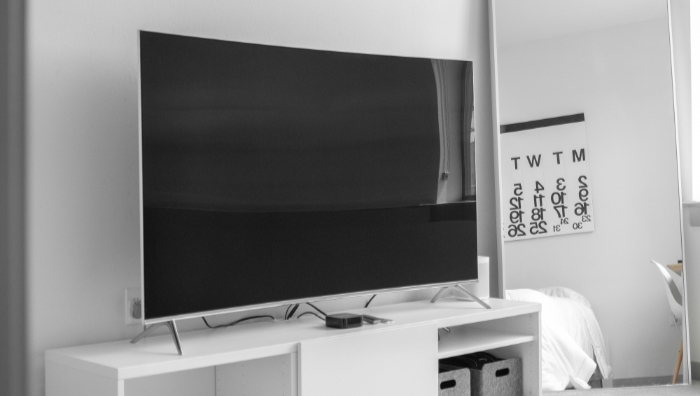OLED vs. UHD: What’s the Difference?
We live in an age where screens constantly surround our lives. Be it at home, work, or school – screens never seem to stop being relevant. Despite this thorough integration of screens in our lives, it is often quite surprising to learn how little people know about screens, their different types, and how they work.
One demonstration of this unawareness is that many people today are still confused about whether OLED screens are better than UHD displays. If you have a similar confusion, keep reading this article to have all of your questions answered.
Why Can’t You Compare OLED to UHD?
While searching to buy a good TV, you will often find people incorrectly comparing OLED screens to 4K (or UHD) screens and passing their judgment on which is best.
However, they don’t realize that comparing OLED to 4K is like comparing apples to oranges– the comparison isn’t valid since both things are entirely separate.
For example, OLED screens with 4K (UHD) resolutions currently exist in the market. There is no point in saying OLED screens are better than UHD resolutions since both of these qualities can be found within a single screen.
To understand this point better, let’s learn what these two terms mean.
OLED Displays Explained
Organic light-emitting diode (OLED) is a light-emitting technology where layers of organic matter produce light when electricity is passed through them.
Like other display technologies, an OLED panel may be used to exhibit pictures, text, video, and more on almost any screen size. Technology has become particularly popular in the TV entertainment sector in recent years.
Many industries also rapidly use it to display performance due to its remarkable image-producing qualities.
OLED displays give off light generated by organic (Carbon-based) molecules when current is passed through them.
Now, let’s discuss the advantages and disadvantages of OLED displays.
Benefits of OLED Screens
Due to the way they are structured internally, OLED screens can offer some unique and unparalleled benefits to their users. Here are the most well-known perks of going for an OLED panel.
Better Contrast
Since OLED panels emit light directly onto the screen, pixels meant to show the color black can be shut off entirely, hence offering darker and convincing blacks and better contrast for viewing.
Other types of screen panels like LED can’t bring about such convincing blacks. This is because these panels achieve black color by hiding the backlighting of the LED panel as much as they can.
Greater Viewing Angles
Since OLED screens are thinner and since OLED panels directly emit their light onto the screen without having to pass through multiple layers of material in between (like on other panels), the light emitted from these panels does not undergo any awkward refraction when viewed from acute angles.
For other panels, this is not the case.
More Responsiveness
A display’s response time indicates the amount of time it takes for any particular pixel to switch on and off in response to an input.
OLED panels yet again take the edge over other types of displays in this aspect as well. The responsiveness of OLED panels goes as fast as one millisecond.
Disadvantages of OLED Display
Now, of course, nothing comes without its fair share of drawbacks. OLED screens are no exception to this rule.
In fact, as with most things, the drawbacks of OLED panels stem from the same things that give the panel its strengths. If you ever think about getting, for example, an OLED TV, you will want to bear these shortcomings in mind.
They Don’t Last Very Long
Since OLED displays are made of organic substances, their lifespans are much shorter than their LCD counterparts.
Limited Screen Brightness
While OLED displays show better ‘blacks,’ these panels fall short in reaching high levels of luminosity – at least compared to other types of screens. In most cases, though, this won’t pose an issue for mainstream consumers.
These panels are bright enough to be viewed easily indoors. The only place this brightness limitation might be noticeable would be in outdoor settings. Nevertheless, even that isn’t a big deal in most cases.
Faster Energy Consumption
This is a big one. OLED displays are infamous for how quickly they drain out batteries. In comparison, other screen technologies like LED hold the ability to run high-quality visuals without draining too much power.
So, OLED panels lose their edge in this aspect.
However, it is essential to mention that this problem will only be noticeable on electronic devices that run on batteries, i.e., phones and tablets.
What Is UHD?
Now that we have a good understanding of what OLED displays are, let’s finally take a brief look at UHD screens. This is where it will become apparent why comparing OLED to UHD is invalid.
Whereas OLED is a type of light-emitting technology, UHD (Ultra High Definition) is what we call a standard for image resolution. Image resolutions indicate the number of pixels present on the vertical and horizontal axis. This number gives us an idea of how sharp and crisp the resulting image would generally be; the more the pixels, the sharper the image.
Nonetheless, it is not so simple. The number of pixels present on a screen alone does not guarantee a sharp image. In order to determine whether this will be the case, we have to look at the pixel density on display. In other words, the number of pixels matters relative to the size of the screen.
A lot of pixels on a small display will make a sharp image. UHD resolutions have a horizontal pixel count of 3840 and a vertical pixel count of 2160. When discussing UHD resolutions, it is important to address one popular misconception between 4K resolutions and UHD resolutions.
These terms are used interchangeably, and it’s hardly anyone’s fault. Businesses have been in the practice of advertising their screens as attractively as they can. In doing so, they’ve often referred to UHD screens as 4K displays due to the similarity in their resolution.
While the difference between the two resolution types is hardly noticeable to ordinary people, it is still important to know how these two terms are different from one another.
4K vs. UHD – How Are They Different?
With rapid advancements in technology, it doesn’t take long for the up and latest technology today to turn outdated and obsolete. This is partly where the confusion between “4K” and “UHD” stems from.
Many people use these two terms interchangeably, and while there is some overlap between them, these two terms aren’t precisely the same, as we mentioned earlier.
The abbreviation “UHD” stands for Ultra High Definition. This standard of pixel resolution directly succeeds Full HD and has a 3840 x 2160 screen resolution (4 times as much as Full HD).
4K, on the other hand, is a cinematic terminology that refers to a horizontal pixel count totaling 4096 and a vertical pixel count totaling 2160 (for television sets). Technically speaking, UHD TV screens can’t have the same resolution quality as 4K TV screens.
However, most people hardly notice this quality difference, especially if they aren’t so discerning when it comes to their technology. The fact that the image resolution on both screens appears similar, combined with the fact that marketers started advertising UHD screens as 4K displays, is the reason behind the popular misconception of these two terms being equal.
Now that we know what UHD resolutions are, let’s consider the pros and cons they bring.
Benefits of UHD Screens
Sharp Images
The most well-known benefit of going for a UHD TV is the fact that they provide an impressively sharp image quality even when the screen is relatively large. So, you can expect smooth transitions, realistic screen movements, and crisp visuals while watching your favorite action movies or shows.
Better Eye Protection
Since there is no image smudging or pixelation effect even as you approach the screen, you can be sure that your eyes will be protected better than on other TVs.
UHD Resolution
Due to its sharpness, it prevents the eyes from getting sore – even after long hours of viewing.
Drawbacks of UHD Screens
Costly
All high-end technologies come at a high monetary cost. UHD resolutions are no exception to this rule. If you’re going for a UHD display (be it on any device you want), you should be prepared to spend a bit more money than you would have for a display with a lower resolution.
4K TVs Make Non-4K Images/Videos Look Worse
If you’ve tried to view non-UHD footage on a UHD display, you know how badly the quality of your footage gets. In some cases, you may even notice the quality appearing even worse than the original footage.
Fewer Content Options
Another major con of a UHD resolution is that in order to avail the full benefits of a UHD resolution, one has to have access to UHD content in the first place.
While there is a lot of UHD content available out there, we are currently still in the stage where we transition to having more UHD content, especially for UHD TVs.
Conclusion
Now, let’s wrap this up. UHD and OLED refer to two different, non-comparable aspects of a display.
OLED screens refer to panels that use carbon-based material to emit light under the influence of electricity.
In contrast, UHD is a standard of image quality or resolution with a 3840 x 2160-pixel ratio.
The popular misconception regarding these two terms is invalid since 4K (UHD) OLED screens exist. This means that there is no point in comparing these two terms since both can exist at the same time.
Additionally, technically speaking, UHD is not the same as 4K either. The similarity in the appearance of these resolutions combined with the popular media practice of advertising UHD TVs as 4K TVs has led to people using these terms interchangeably while they’re actually not.
Finally, here is a quick summary of the major pros and cons that OLED displays and UHD resolutions bring to the table:
Pros and Cons of OLED Displays
Pros
- Better contrast
- Wider viewing angles
- High responsiveness
Cons
- Shorter lifespan
- High energy consumption
- Limited peak brightness
Pros and Cons of UHD Resolution
Pros
- Sharp images
- Better protection for eyes
Cons
- High monetary cost
- UHD TVs make non-UHD content look worse
- Fewer content options are available






